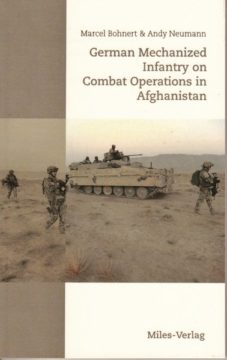(1) Prologue: »Operation Tür«
(Kunduz, Afghanistan, September 2011)
September 9 is a day that many of us will remember for a very long time. It has a special significance for many Afghans, too: it is the national day of remem-brance in honor of Ahmad Shah Massoud. The ethnic Tajik became a legend in the late 1980s in the fight against the Soviet army and as the leader of the Muja-hideen fighters, and later became a figure symbolizing the resistance against the Taliban. On 9 September 2001, Massoud died in an attack carried out by two suicide bombers disguised as journalists. Shortly thereafter he was officially declared a national hero by the Afghan President.
Exactly ten years later, the engines of German infantry combat and other armored vehicles were to be heard in the northern Afghan province of Kunduz. The Bundeswehr had been involved in the war in the Hindu Kush for almost a decade now. Over the years, the ISAF mission had developed from a humanitarian stabilization operation into a combat mission and has led to casualties among Bundeswehr and other Alli-ance members. In 2010, the then Major General Hans-Werner Fritz had activated German training and pro-tection battalions which were to operate in the front-line as two fully-equipped task forces: Task Force Kunduz and Task Force Mazar-E-Sharif. By that point at the latest, consideration was finally being given to the changed threat situation at tactical level.
As part of Task Force Kunduz III we began »Opera-tion Tür« in the early morning hours of 9 September 2011 in the troubled district of Chahar Darreh. Our intent was to recover two APC Dingo doors left be-hind in the small town of Isa Khel since the Good Friday fire fights of 2010. They bore witness to that bloody day on which three German soldiers had died and several others had been wounded in heavy fight-ing. Aside from the Kunduz bombing in Septem-ber 2009, Good Friday 2010 is considered to be the break or turning point in how the public perceived Germany’s mission there.
Reinforced infantry platoon Bravo, comprising mounted and dismounted forces, was now at the loca-tion of those past events. Despite the early hour, the thermometer was already showing more than 40 de-grees (100 degrees Fahrenheit), and the heavily laden soldiers were making their way into the small town. Engineers and EOD specialists scanned the ground for booby traps while, under their protection, the ar-mored vehicles pushed on gradually to the river where the company’s infantry forces had discovered the doors several weeks before. The dismounted forces conversed with locals and secured the advance of the combat vehicles in all directions. Towards 10:30 hrs, shortly after the arduous recovery of the doors weigh-ing several hundred pounds, the company received information that a combat patrol sent out by the recce company had come under IED attack on the Western Plate of the high plateau near the small town of Nawabad and that German soldiers had been wounded. The operation in Isa Khel was broken off immediately and, after a halt at Hill 432 for coordina-tion purposes during which vital support forces were integrated into already present mechanized infantry platoon Charlie, the alerted forces deployed at full speed to the location of the attack almost ten kilome-ters (six miles) away. The lead Marder armored infan-try combat vehicle (AICV) overheated and broke down at a choke point shortly before reaching the ap-proach to the Western Plate. The Marder following behind pushed it off the road despite the risk of dam-aging its cooling system, enabling the road march to rapidly continue. During our approach we were es-corted by US Black Hawk helicopters that were already in the process of landing and taking on one of the wounded just less than a kilometer (half a mile) away before we reached the site of the attack. Accepting high personal risk, they set down, as they so often do, in a „hot zone“, thus ensuring fast medical treatment.
After the AICVs had established a defensive perimeter at the site of the attack, our EOD specialists carried out a search to minimize the threat of secondary IEDs. The accompanying recovery forces from Camp Kun-duz loaded the destroyed scout vehicle onto a heavy equipment transporter and then withdrew under our watchful eyes. Contrary to the original operation plan-ning for the company, Bravo platoon then made dis-positions to spend the night on the Western Plate and, in poor visibility, conducted light reconnaissance pa-trols on the outskirts of Nawabad so as to avoid giving the enemy any feeling of triumph. That same night a BM-1 missile fired from the north eastern part of Isa Khel impacted in the immediate vicinity of Camp Kunduz. A post-blast analysis carried out on site on 11 September 2011 together with Afghan security forces yielded no information on the offenders, how-ever. Also that same evening, another missile was fired in the direction of the camp. Consequently, 2nd and 3rd Companies alternately deployed sniper teams ac-companied by infantry who took up positions to ob-serve Isa Khel. Although they did not gather any par-ticular reconnaissance information, they did, temporar-ily at least, prevent further missiles from being fired at the camp.
- Veröffentlicht am Sonntag 27. November 2016 von Miles-Verlag
- ISBN: 9783945861455
- 100 Seiten
- Genre: Gesellschaft, Politik, Sachbücher, Wirtschaft
